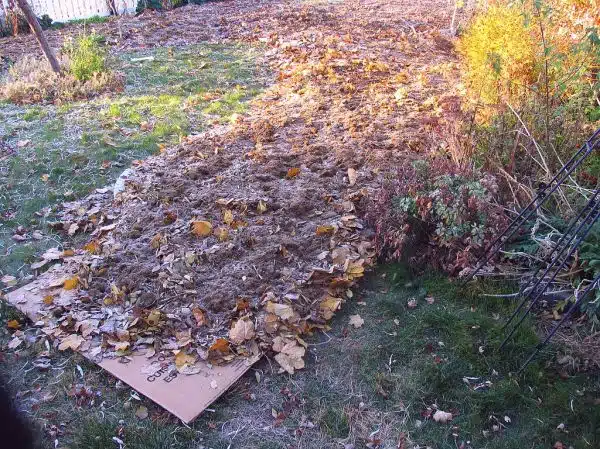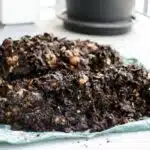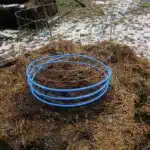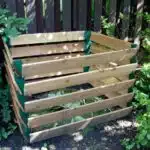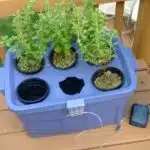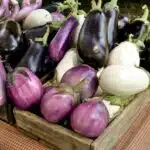Lasagna gardening is a popular technique that has captured the imagination of gardeners all over the world. This innovative method involves layering organic materials on top of each other to create a rich and fertile soil environment for plants to grow in. The result is a garden that requires little maintenance, produces minimal waste, and yields bountiful crops year after year.
The beauty of lasagna gardening lies in its simplicity. By using readily available organic materials such as leaves, straw, compost, and grass clippings, you can easily build up layers of soil that are teeming with life. These layers provide a perfect habitat for earthworms, beneficial microbes, and other organisms that work together to break down the organic matter and release valuable nutrients into the soil. In this article, we will explore the steps involved in creating your own lasagna garden and offer some tips on how to make it thrive. Whether you are an experienced gardener or just starting out, lasagna gardening is a fun and rewarding way to grow your own food and contribute to a sustainable future for all.
Understanding The Principles Of Lasagna Gardening
Lasagna gardening is a revolutionary way of cultivating plants that has gained popularity in recent years. This method involves layering organic materials such as leaves, grass clippings, and kitchen scraps to create a nutrient-rich soil bed for your plants. By mimicking the natural process of decomposition, lasagna gardening allows you to grow healthy crops without tilling the soil or using chemical fertilizers.
One of the major benefits of lasagna gardening is that it saves time and effort compared to traditional methods. Instead of digging up an entire section of your yard, you can simply add layers on top of the existing soil. This also means that you don’t have to worry about disturbing any beneficial microbes or earthworms that are already present in the soil. However, there are also some drawbacks to this method. For instance, it may take longer for your plants to establish themselves since they have to work their way through several layers before reaching the nutrient-rich bottom.
If you’re new to lasagna gardening, there are a few tips that can help you get started. First and foremost, it’s important to choose materials that will break down quickly and provide enough nutrients for your plants. Some good options include coffee grounds, eggshells, and vegetable scraps. Additionally, make sure to water each layer thoroughly as you go along to encourage decomposition. Finally, be patient – lasagna gardening takes time but yields bountiful rewards in the end.
To begin your journey towards successful lasagna gardening, choosing the right location for your garden is crucial.
Choosing The Right Location For Your Garden
Understanding the principles of lasagna gardening is crucial to the success of your garden. One important factor to consider when creating a lasagna garden is choosing the right location. The benefits of sunlight cannot be overstated, so it’s essential to choose a spot that receives at least six hours of direct sunlight every day.
Another critical aspect to consider when selecting your garden location is avoiding waterlogged areas. Waterlogging can cause root rot and other problems for your plants, leading to poor growth and yield. Therefore, it’s best to avoid low-lying areas or spots where water tends to pool after rain.
Overall, choosing the right location for your lasagna garden is essential for its long-term success. By ensuring ample sunlight and avoiding waterlogged areas, you’ll create an environment that promotes healthy plant growth and thriving crops. In the next section, we’ll discuss how to gather organic materials for your layers and start building your lasagna garden in earnest.
Gathering Organic Materials For Your Layers
Composting is a great way to create an organic material for your layers as it is a way of breaking down organic materials into a nutrient-rich material. Manure is another organic material to consider, as it is a great source of nitrogen and other essential nutrients. Mulching can be used as a protective layer and also adds organic material to the soil. Worms are essential for breaking down organic material in the soil, and adding them to your lasagna garden is a great way to improve the soil health. Soil is essential for lasagna gardening, and it should be a nutrient-rich material. Fertilizer can be used to supplement the soil and provide additional nutrients.
Composting
Composting is a great way to gather organic materials for your lasagna garden. Composting benefits are numerous, as it is an affordable and eco-friendly method of recycling kitchen scraps and yard waste into nutrient-rich soil amendments. Organic matter in compost improves soil structure, increases water retention capacity, and enhances the growth and health of plants.
DIY composting bins are perfect for small-scale gardening projects. They can be made from various materials such as wooden pallets, chicken wire or plastic containers. The key to successful composting is to maintain the right balance between carbon-rich ‘brown’ materials such as dry leaves, straw, and shredded paper, and nitrogen-rich ‘green’ materials like grass clippings, vegetable peels or coffee grounds. Regular turning of the compost pile also helps to speed up decomposition by allowing oxygen to penetrate the pile.
In summary, composting offers an easy way to gather organic materials for your lasagna garden while reducing waste and promoting sustainability. DIY composting bins provide a low-cost option for gardeners looking to create their own rich soil amendment. Properly managed compost piles can produce high-quality organic matter that will improve soil fertility and support vigorous plant growth without the use of harmful chemicals or synthetic fertilizers.
Manure
To gather organic materials for your lasagna garden, you can also consider using manure. Manure is an excellent source of nutrients that can improve soil fertility and support plant growth. However, not all types of manure are created equal, and some may contain high levels of pathogens or weed seeds that could harm your plants. Therefore, it is important to choose the right type of manure and compost it properly before adding it to your garden.
Composting tips for manure include mixing it with carbon-rich materials such as straw or sawdust to balance its nitrogen content and prevent odors. You should also ensure that the compost pile reaches a temperature of at least 130 degrees Fahrenheit for several days to kill any pathogens or weed seeds present in the manure. Once composted, the resulting material can be used as a soil amendment or top dressing around plants.
Some common types of manure that are suitable for gardening include cow, horse, chicken, and rabbit manure. Cow and horse manure are good sources of nitrogen and potassium but may contain weeds if not composted properly. Chicken and rabbit manure are higher in nitrogen than other types but must be carefully composted to avoid burning plants due to their high ammonia content. By choosing the right type of manure and composting it appropriately, you can add valuable nutrients to your lasagna garden while minimizing risks to plant health.
Mulching
Gathering organic materials for your lasagna garden is an essential step towards creating a nutrient-rich environment that supports plant growth. In addition to manure, another useful material that can benefit your garden is mulch. Mulch is a layer of organic or inorganic material placed on top of the soil to conserve moisture, regulate temperature, and suppress weed growth.
The benefits of mulching are numerous. It helps to retain soil moisture by reducing evaporation, which is especially important during hot and dry weather conditions. Mulch also regulates the temperature of the soil by keeping it cooler in the summer and warmer in the winter, which promotes root development and overall plant health. Furthermore, mulch acts as a natural weed suppressant by blocking sunlight from reaching weed seeds, preventing them from germinating and competing with your crops.
There are several types of materials that can be used as mulch in your lasagna garden. Organic materials such as straw, leaves, grass clippings, wood chips or bark provide nutrients to the soil as they decompose over time. Inorganic options like plastic sheeting or gravel do not break down but still provide benefits such as conserving moisture and suppressing weeds. When choosing a type of mulch for your garden, consider factors such as availability, cost-effectiveness, and aesthetic appeal to ensure you make an informed decision that best suits your needs.
Preparing The Ground For Your Lasagna Garden
Before building your lasagna garden, it is important to prepare the ground properly. This will ensure that your garden has a strong foundation and will produce healthy plants. The first step is to remove any grass or weeds from the area where you plan to build your garden. You can do this by using a shovel, hoe, or other gardening tools. Once the area is cleared, you should loosen the soil with a tiller or garden fork. This will help your plants establish roots more easily.
One of the benefits of lasagna gardening is that it can be done on any type of soil, including poor soil. However, if your soil is extremely compacted or lacks nutrients, you may need to amend it before building your garden. You can do this by adding compost or other organic materials to the soil. This will improve its structure and provide essential nutrients for your plants.
Troubleshooting common issues in preparing the ground for your lasagna garden involves ensuring proper drainage and avoiding overcompaction of the soil during preparation. If water does not drain well in the area where you plan to build your garden, consider installing drainage tiles or creating raised beds. In addition, avoid walking on or otherwise compacting the soil too much during preparation as this can hinder root growth and nutrient absorption.
Next up: Building the Base Layer of Your Garden
Building The Base Layer Of Your Garden
- When preparing the site for a garden, it is important to consider the amount of sunlight received, the soil type, and any pre-existing conditions that may affect the health of plants.
- Selecting an appropriate container for a garden is essential, as the size and type of container will determine the number of plants that can be accommodated.
- Designing the layout of the garden is a crucial step to ensure that plants have adequate space and the right environment to thrive.
- Prior to planting, it is important to build a base layer of organic materials such as compost, leaves, and straw to help retain moisture and add nutrients to the soil.
- A lasagna garden is a type of garden that is created by layering organic materials and soil in order to create a fertile environment for plants.
- Lasagna gardening is a great way to create a garden in any space, as it is not dependent on soil type or climate.
Preparing The Site
To prepare the site for building a lasagna garden, it is important to start by choosing the right materials. Organic materials such as leaves, grass clippings, and kitchen scraps make excellent base layers for lasagna gardens. Additionally, cardboard or newspaper can be used to create a barrier that will prevent weeds from growing up through the garden. When selecting these materials, it is important to ensure that they are free of chemicals that could harm the plants in the garden.
Once you have chosen your materials, it is time to clear the area where you will be building your garden. This involves removing any existing vegetation and debris from the site. It may also involve tilling the soil if you plan to incorporate a traditional gardening layer into your lasagna garden. When clearing the area, be sure to remove any rocks or other large objects that could interfere with plant growth.
After you have cleared the area and chosen your materials, it is time to begin building your lasagna garden! Start by laying down a layer of cardboard or newspaper over the entire area. This will serve as a barrier between your organic material layers and any existing weeds or grasses in the soil. From there, you can begin adding layers of organic material such as leaves, grass clippings, and kitchen scraps until you reach your desired height. Remember to keep each layer moist and well aerated to encourage decomposition!
Selecting A Container
When building a garden, selecting the right container is crucial. There are many container options available for gardening, including traditional pots, raised beds, and even repurposed items such as old buckets or barrels. When selecting a container, it is important to consider the size of the plants you will be growing and the space available in your yard or patio.
Size considerations are important when choosing a container for your garden. If you plan to grow larger plants such as tomatoes or peppers, you will need a larger container that can hold enough soil and provide enough space for root growth. On the other hand, smaller plants like herbs or lettuce can thrive in smaller containers. Additionally, it is important to ensure that your chosen container has proper drainage to prevent waterlogging and root rot.
When selecting a container for your garden, remember that there are many options available and no one-size-fits-all solution. Consider your plant selection and available space when making your choice. With the right container and proper care, you can create a thriving garden anywhere!
Designing The Layout
After choosing the right container for your garden, it’s time to focus on designing the layout. The layout design is an essential aspect of gardening that requires careful consideration to optimize space and ensure healthy plant growth. A well-designed garden layout will not only look beautiful but also make plant care more manageable.
The first step in designing your garden layout is to determine which plants you want to grow and their ideal growing conditions. Some plants require more sunlight than others, while some prefer shade. Grouping plants with similar requirements can help optimize space and make watering and fertilizing more efficient. Additionally, consider the size of each plant when planning its placement in the container or raised bed.
Another important aspect of garden layout design is creating pathways for easy access when gardening or harvesting. Pathways can be created using materials such as gravel or stepping stones and should be wide enough for comfortable movement without damaging any plants. Creating a designated area for tools and supplies can also help keep your garden organized and tidy.
In conclusion, designing the layout of your garden is just as crucial as selecting the right container for planting. Optimize space by grouping plants with similar needs, considering their size, and creating pathways for easy access. With a well-designed layout, you can create a beautiful and productive garden that serves both aesthetics and functionality.
Adding Layers Of Organic Materials
Layering organic materials is the key to making a successful lasagna garden. The benefits of layering are numerous, as it creates an environment that promotes healthy plant growth and reduces the need for synthetic fertilizers. By adding layers of organic matter, you can create a nutrient-rich soil that will provide a long-lasting source of nutrients for your plants.
Experimenting with different organic materials is essential when creating a lasagna garden. There are many different types of organic matter that can be used, such as grass clippings, leaves, straw, cardboard, and even kitchen scraps. Each material has its unique properties and can contribute to the overall health of your garden in different ways. For example, grass clippings can add nitrogen to the soil while leaves can improve soil structure.
Incorporating various organic materials into your lasagna garden will help to create a diverse ecosystem that supports a wide range of beneficial microorganisms. These microorganisms break down the organic matter and release nutrients into the soil, which helps to feed your plants naturally. Experiment with different combinations of materials until you find what works best for your specific needs. In the next section, we will explore how using compost can boost nutrients in your lasagna garden even further.
Using Compost To Boost Nutrients
After adding layers of organic materials, it’s time to enhance the nutrient richness of your soil. This is where composting techniques come into play. Composting is the process of breaking down organic matter into a nutrient-rich soil amendment that can be added to your garden beds. Composting involves mixing together brown and green materials such as leaves, grass clippings, vegetable scraps, and wood chips in a bin or pile and allowing them to decompose over time with the help of microorganisms.
There are several different composting techniques you can use in your lasagna garden. One popular method is vermicomposting, which involves using worms to break down organic matter into compost. Another option is hot composting, which involves turning the compost frequently and maintaining a high temperature to speed up decomposition. Whichever method you choose, adding compost to your lasagna garden will help improve soil structure, increase water retention, and provide essential nutrients for your plants.
By using these composting techniques and incorporating nutrient-rich soil amendments like compost into your lasagna garden layers, you’ll be well on your way to creating a thriving garden bed full of healthy plants. In the next section, we’ll discuss how to ensure that your plants receive enough water to grow strong and healthy. Proper watering techniques are crucial for maintaining a healthy garden bed.
Watering Your Lasagna Garden
As your lasagna garden begins to take root, it’s important to ensure that the plants receive an adequate supply of water. Watering is critical for healthy plant growth and development. Without sufficient water, plants may wither and die, leaving you with an unproductive garden. In this section, we’ll discuss two methods for watering your lasagna garden: rainwater harvesting and drip irrigation.
Rainwater harvesting is a cost-effective way to water your garden while conserving water. This method involves collecting rainwater in barrels or other containers for later use. By doing so, you can reduce your reliance on municipal water supplies and save money on your water bill. To set up a rainwater harvesting system, you’ll need to purchase a rain barrel or construct one from scratch. Place the barrel beneath a downspout or gutter that collects rainwater from your roof. You can then use this stored water to irrigate your lasagna garden as needed.
Drip irrigation is another effective method for watering your lasagna garden. This technique involves delivering small amounts of water directly to the roots of each plant through a series of tubes or hoses. Drip irrigation systems are highly efficient because they minimize evaporation and runoff, which can waste water and harm the environment. To set up a drip irrigation system in your lasagna garden, you’ll need to purchase tubing or hoses designed for this purpose and connect them to a timer or controller that regulates the flow of water. With proper installation and maintenance, drip irrigation can provide consistent moisture to your plants throughout the growing season.
As you begin watering your lasagna garden using either rainwater harvesting or drip irrigation, pay attention to how much water each plant needs and adjust accordingly. Over-watering can be just as harmful as under-watering, so it’s important to strike the right balance. In the next section, we’ll discuss another important step in maintaining a healthy lasagna garden: mulching to retain moisture.
Mulching To Retain Moisture
- Mulch is a protective cover that can be used on soil to help retain moisture, reduce erosion, and regulate soil temperature.
- The two main types of mulch used in gardening are organic and inorganic.
- Organic mulch, such as bark chips, compost, and grass clippings, provides nutrients to the soil as it breaks down.
- Inorganic mulch, such as stone, plastic, and rubber, provides an effective barrier to prevent weed growth.
- Mulching can provide protection from disease and pests and help to reduce water loss in soil.
- When applying mulch, it should be spread in a thin layer, avoiding direct contact with plant stems and trunks.
Types Of Mulch
When it comes to retaining moisture in your garden, mulching is one of the most effective methods. Mulch not only keeps soil moist, but also prevents weed growth and adds nutrients to the soil through decomposition. However, not all types of mulch are created equal.
The best types of organic materials for mulching are those that decompose slowly and provide long-lasting benefits to the soil. Composting benefits can be maximized by using composted leaves, grass clippings, or straw as mulch. These materials break down slowly over time, releasing nutrients into the soil and improving soil structure.
Other organic options include shredded bark or wood chips, which not only retain moisture but also add aesthetic value to your garden. However, it’s important to note that these materials may take longer to break down and therefore won’t provide as much immediate benefit as composted materials. Regardless of which type of organic material you choose, proper application is key in order to reap the full benefits of mulching for moisture retention in your lasagna garden.
Benefits Of Mulching
Mulching is one of the most effective techniques for retaining moisture in your garden. It not only keeps soil moist but also prevents weed growth and adds nutrients to the soil through decomposition. There are various types of mulch available, including organic and inorganic materials, with organic mulches being the preferred option for serving a dual purpose of improving soil health as well as moisture retention.
The benefits of mulching go beyond just moisture retention. Mulching provides a protective layer that helps regulate soil temperature, reducing heat stress on plants during hot weather conditions. It also helps prevent soil erosion by shielding the ground from heavy rains or winds. Additionally, mulch reduces the amount of water needed for irrigation and promotes healthy root growth by providing a suitable environment for microorganisms that break down organic matter.
Composting with mulch is an excellent way to maximize the benefits of both practices. Composted materials such as leaves, grass clippings, or straw provide long-lasting benefits to the soil while breaking down slowly over time, releasing nutrients into the soil and improving its structure. Alternative mulching materials such as shredded bark or wood chips are also effective at retaining moisture but may take longer to break down and therefore won’t provide as much immediate benefit as composted materials. Regardless of which type of organic material you choose, proper application is key in order to reap the full benefits of mulching for moisture retention in your garden.
Applying Mulch
Mulching is a highly effective technique for retaining moisture in your garden and providing a host of other benefits to your plants. One important aspect of mulching is the proper application of mulch, which should be done with careful consideration to ensure maximum benefits. Applying mulch can help regulate soil temperature, reduce heat stress on plants during hot weather conditions and prevent soil erosion by shielding the ground from heavy rains or winds.
There are various types of mulch available, including organic and inorganic materials. Organic mulches are recommended because they provide a dual purpose of improving soil health as well as moisture retention. These materials break down slowly over time, releasing nutrients into the soil and improving its structure. Composting with mulch is an excellent way to maximize these benefits. Composted materials such as leaves, grass clippings, or straw provide long-lasting benefits to the soil while breaking down slowly over time.
When applying mulch, it is important to apply it properly so that it does not interfere with plant growth or cause other problems. A layer of 2-3 inches should be applied around plants, but not directly against their stems or trunks. This will help prevent rotting and disease issues caused by excessive moisture around the base of plants. Additionally, care should be taken when applying mulch around trees to avoid creating a “mulch volcano” which can lead to root rot and other problems. By following these guidelines for proper application, you can enjoy all the benefits that mulching has to offer for retaining moisture in your garden while ensuring healthy plant growth.
Planting Your Crops
Now that you have prepared your lasagna garden, it’s time to plant your crops. Crop rotation is essential in maintaining a healthy garden bed. By rotating the crops every season, you prevent soil depletion and reduce the risk of disease and pests. When selecting what to plant, consider companion planting as well. Certain plants benefit from growing next to each other, while others can inhibit growth or attract pests.
Before planting, make sure to research the specific needs of each crop you intend to grow. Some plants may require more sunlight or water than others, while some may prefer different soil types. Once you have determined which crops are suitable for your garden bed, create a plan for their placement based on their individual requirements.
To further enhance the health of your lasagna garden bed, consider adding a nested bullet point list with three sub-lists:
- The first sub-list could include details about how certain plants can benefit from being planted together and how certain pairings can decrease pest infestations.
- The second sub-list could explain how crop rotation works and how it helps maintain soil fertility while reducing disease prevalence.
- The third sub-list could discuss how intercropping (planting multiple crops in one area) can increase yields and improve soil health.
By implementing these practices into your planting strategy, you will be well on your way to a successful lasagna garden harvest.
As we move forward with maintaining our lasagna garden beds, it’s important to remember that proper care is crucial for continued success. In the next section, we will discuss methods such as fertilization and watering techniques that will help keep our gardens thriving throughout the season.
Maintaining Your Lasagna Garden
Now that you have successfully set up your lasagna garden, it is essential to know how to maintain it for optimal growth and yield. One of the keys to success is ensuring that the soil remains moist but not waterlogged. Water your garden regularly, especially during dry periods. However, be careful not to overwater as this can lead to root rot and other soil-borne diseases.
Another crucial aspect of maintaining a healthy lasagna garden is organic pest control. Pest infestations can quickly destroy your crops if left unchecked. Consider companion planting as a natural way of deterring pests. This involves planting certain species of plants together, which help repel insects or attract beneficial ones like ladybugs that feed on pests. Additionally, use organic solutions like neem oil or soap sprays instead of synthetic pesticides, which can harm beneficial insects and contaminate the soil.
In conclusion, maintaining a lasagna garden requires attention and care to ensure optimal growth and yield. Ensure proper watering while avoiding overwatering, and consider companion planting to deter pests naturally. Finally, keep in mind that using organic pest control methods like companion planting and natural solutions like neem oil will help maintain a healthy and thriving garden without harming the environment or beneficial insects. In the next section, we’ll discuss how to deal with pests and diseases that may still affect your lasagna garden despite your best efforts at prevention.
Dealing With Pests And Diseases
One of the biggest challenges when growing crops is dealing with pests and diseases that can devastate your garden. However, there are natural pest control methods that you can use to protect your plants without resorting to harmful chemicals. For instance, companion planting is an effective way to deter pests and attract beneficial insects. You can plant flowers like marigolds or herbs like basil alongside your vegetables to repel pests naturally.
Another way to prevent pest infestations is by using disease-resistant crops. These plants have been specifically bred to resist common diseases and pests that affect their species. By choosing these varieties, you can minimize the risk of crop failure due to disease or pest damage. Some popular disease-resistant crops include tomatoes, cucumbers, and squash.
In addition to these methods, here are three other natural ways you can keep pests and diseases at bay:
- Use organic pesticides made from natural ingredients like garlic, neem oil, or soap.
- Mulch your garden beds with materials like straw or leaves to discourage weeds and retain moisture.
- Rotate your crops every season to prevent soil-borne diseases from building up in the same spot.
By incorporating these techniques into your lasagna gardening practices, you can enjoy a healthy harvest free from pesky intruders. In the next section, we will discuss how to know when it’s time for harvesting your crops without compromising their quality or yield.
Harvesting Your Crops
Harvesting your crops is an exciting time in the garden. It’s the culmination of all your hard work and dedication to growing a successful lasagna garden. The goal is to maximize yield by harvesting at the right time and preserving your harvest properly.
To maximize yield, it’s important to harvest at the right time. This means waiting until the vegetables are fully matured before picking them. For example, tomatoes should be picked when they are fully red and peppers when they have turned their final color. Harvesting too early will result in less flavorful vegetables that may not ripen properly off the vine.
Preserving your harvest is just as important as harvesting at the right time. There are many ways to preserve your vegetables, including canning, freezing, and pickling. Each method has its own benefits and drawbacks, so it’s important to choose the method that works best for you and your family. Properly preserving your harvest ensures that you can enjoy the fruits of your labor long after the growing season has ended.
As you finish up this year’s harvest, start thinking about renewing your lasagna garden for next season. One way to do this is by composting any leftover plant material from this year’s garden into next year’s soil mix. This helps to enrich the soil with nutrients while also reducing waste in landfills. Another way is to plan which crops you want to grow next year based on what worked well this year and what didn’t. By taking these steps, you’ll be able to ensure another successful season in your lasagna garden next year.
Renewing Your Lasagna Garden For Next Season
To ensure the success of your lasagna garden for next season, it is important to renew the soil and prepare it for planting. One way to do this is through crop rotation. By rotating your crops, you can avoid depleting the same nutrients from the soil each year and prevent soil-borne diseases from taking hold. It is recommended to rotate between three or four different crop families, such as legumes, brassicas, nightshades, and cucurbits.
Another way to maintain a healthy lasagna garden is through companion planting. This involves planting certain plants together that have beneficial effects on one another. For example, planting marigolds with tomatoes can help deter pests and improve tomato growth. Similarly, planting beans with corn can help fix nitrogen in the soil and benefit both crops.
When preparing your lasagna garden for next season, consider incorporating these tips into your plan. Not only will they help maintain a healthy garden, but they can also increase yield and reduce pest problems. With proper care and attention, your lasagna garden will continue to thrive year after year.
Transitioning into the subsequent section about ‘conclusion: enjoying the fruits of your labor’, it is important to keep in mind that renewing your lasagna garden for next season is just one step in creating a successful harvest. In order to fully enjoy the benefits of your hard work, it is essential to properly care for and tend to your garden throughout the growing season. The following section will provide tips on how to do just that.
Conclusion: Enjoying The Fruits Of Your Labor
After all the hard work of creating a lasagna garden, it’s time to sit back and enjoy the fruits of your labor. Celebrating success is an important part of any gardening journey, and there are many ways to do so. Perhaps you can invite friends or family over for a garden party or cook a meal using the fresh produce from your garden. Sharing your harvest with loved ones is not only rewarding but also helps spread the joy of gardening.
One way to share your harvest is by creating a table display showcasing the different types of vegetables and herbs you’ve grown in your lasagna garden. A visually appealing display can spark curiosity and conversation about the benefits of gardening and inspire others to try it for themselves. Consider including some information on how you created your lasagna garden, as well as some tips for growing each type of plant.
Another way to share your harvest is by donating excess produce to local food banks or community organizations. Many people are unable to access fresh, healthy food, and donating your surplus can make a big difference in their lives. Not only will you be helping others, but you’ll also feel good knowing that your hard work is making a positive impact in the community.
Sharing the bounty of a lasagna garden is one of the most satisfying parts of gardening. Whether it’s through hosting a gathering, creating a beautiful display or donating excess produce, celebrating success and sharing your harvest can bring joy not only to yourself but also to those around you.
Conclusion
Lasagna gardening is a highly effective method of gardening that involves stacking layers of organic materials to create a nutrient-rich soil for your crops. This technique is perfect for those who want to grow their own produce but do not have access to traditional soil-based gardens. The success of lasagna gardening depends on proper planning and execution, which we have outlined in this article.
To begin, it is important to understand the principles of lasagna gardening and choose the right location for your garden. Gathering organic materials for your layers and preparing the ground for your garden are also crucial steps in ensuring its success. Building the base layer and dealing with pests and diseases are equally important to ensure healthy growth of your crops.
Once you have harvested your crops, it is time to renew your lasagna garden for next season. This will involve adding new layers of organic material and tending to the soil as needed. It is important to note that patience is required when using this technique since results may take longer than expected.
In conclusion, while lasagna gardening may seem like a whimsical idea, it is actually a scientific approach that requires careful consideration and attention to detail. With proper planning and execution, one can enjoy the fruits of their labor in the form of fresh produce grown right at home. So go ahead, give it a try and see how deliciously rewarding it can be!
Image Credits
- “lasagna garden in progress 12x” by naturalflow (featured)

